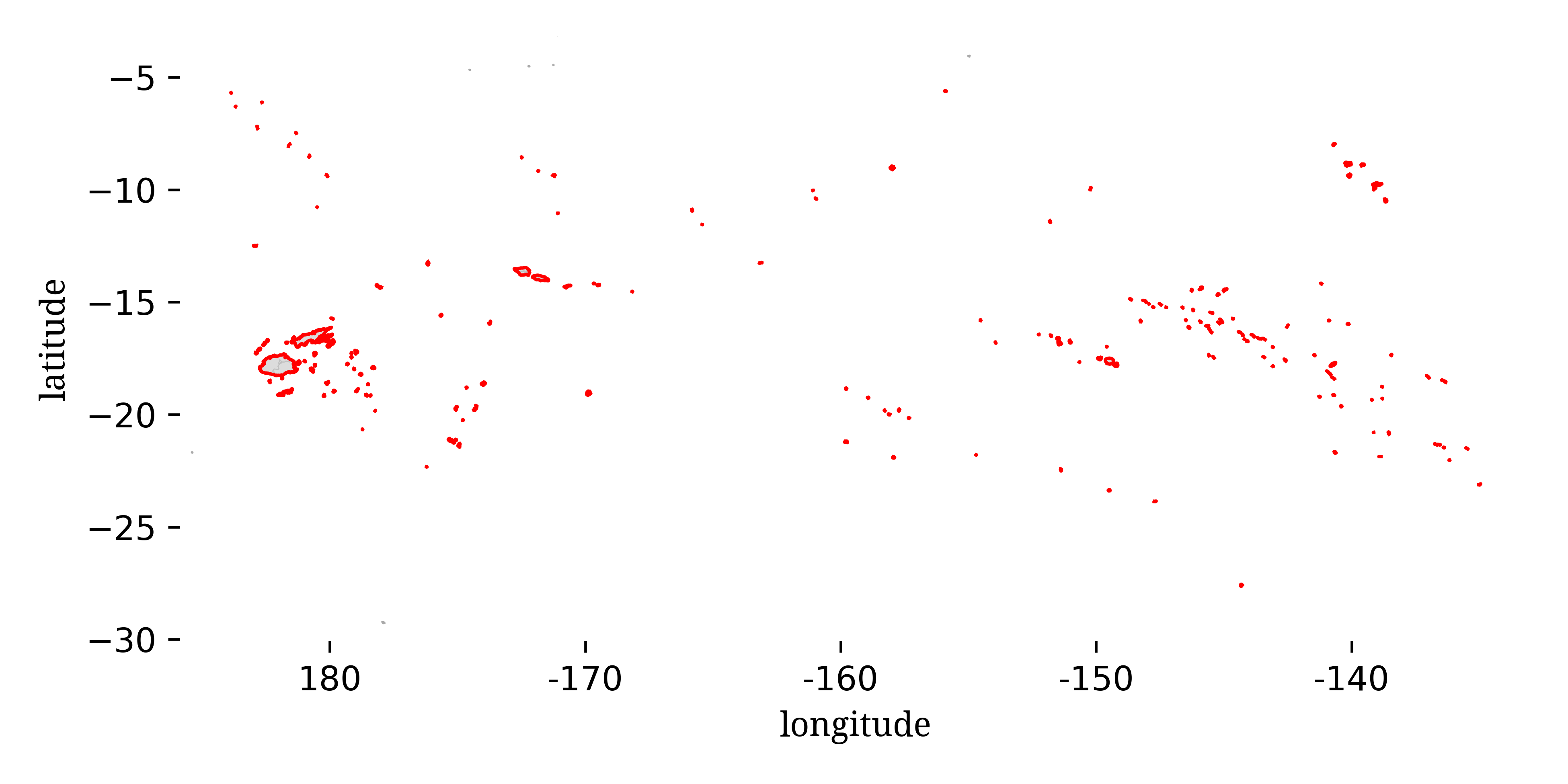
This guide is designed for identification “in the field” where you might be looking at live crabs by eye or through binoculars or from photographs. I will generally try to avoid characters that will require you to physically catch the crab, although I may mention a few for secondary verification. It does not include the more strict taxonomist-style characters that may only be visible under a microscope or via dissection. It is also assumed that the individuals are living, as death (and even capture) can cause dramatic color change.

This is a guide to the fiddler crabs of Fiji (the eastern most part of Melanesia) and Polynesia, including Tuvalu, Wallis and Futuna, Tonga, Samoa, American Samoa, the Cook Islands, and French Polynesia (but excluding New Zealand, Hawaii, Easter Island, and the Pitcairn Islands, none of which have fiddler crabs). Only five species reach this far into the Pacific and most of these islands only have three:
Two of the species are endemic to this region (Austruca citrus and Gelasimus excisa), both of which appear very similar to sibling species found in the more western part of the Pacific (Austruca perplexa and Gelasimus jocelynae, respectively). By and large, the species in this region should be readily identifiable.
A number of features can be used to distinguish among these species, but a good place to start is to look at the distance between the base of the eyestalks. Fiddler crabs tend to split into two groups, those with the eyestalks very close together (“narrow front”) and those with the eyestalks separated a bit more (“broad front”). Two of these species (Austruca citrus and Paraleptuca crassipes) are broad front species, while the other three (Gelasimus excisa, Gelasimus tetragonon, and Tubuca coarctata) are narrow front species. Note that the carapace between the eyestalks appears pinched together in the narrow front species, but more trapezoidal in the broad front species.
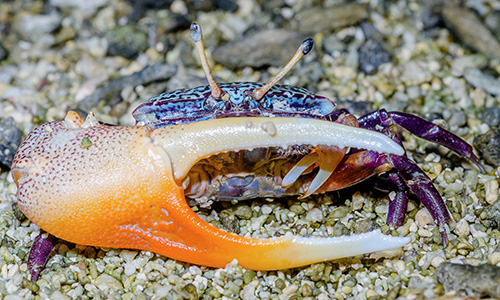
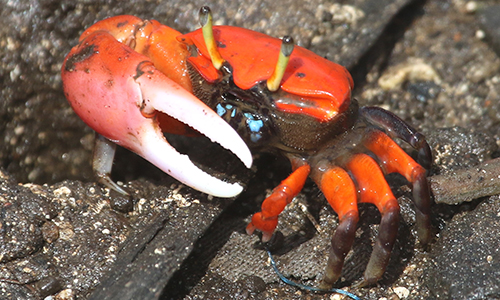
Austruca citrus is endemic to this region and easily identifiable as a broad front species with a bright yellow claw. Its carapace and legs are generally marbled dark and light browns and creams, but in some cases maybe be entirely yellow.
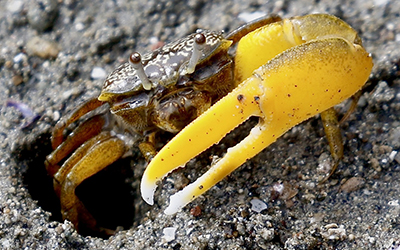
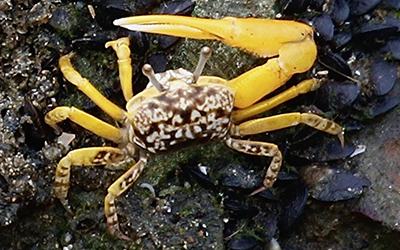
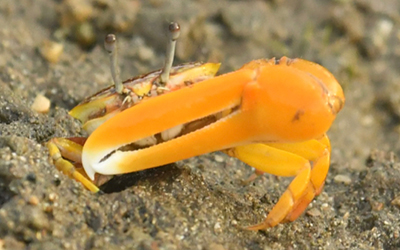
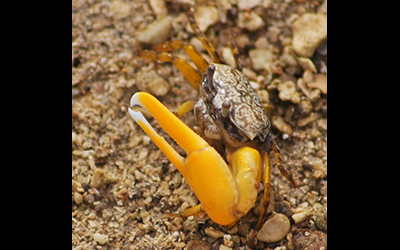
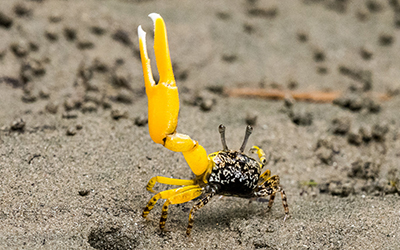
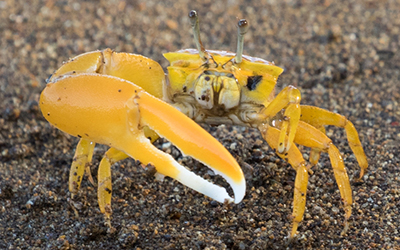
The other broad front species in this region, Paraleptuca crassipes is easily distinguishable from Austruca citrus by color. The colors of Paraleptuca crassipes do overlap with one of the narrow front species, Tubuca coarctata, described below.
Paraleptuca crassipes is a highly variable species with a carapace that is generally some combiantion of black, pale blue, and bright red—occasionally with a hint of yellow or green—with solid red and all-but-solid black carapaces not uncommon (it seems never to be solid blue). It's eyestalks are usually yellow-green, but sometimes red, particularly in individuals with heavily red carapaces. The large claw is bright red-to-reddish pink, with paler pink or white fingers.
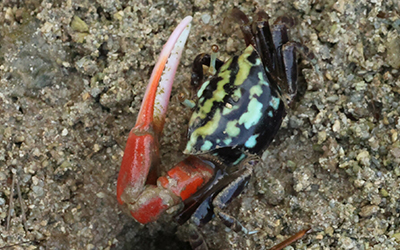
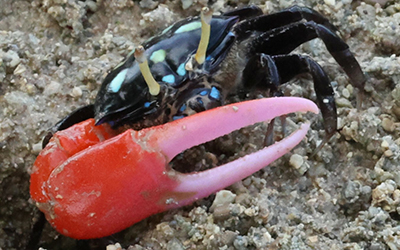
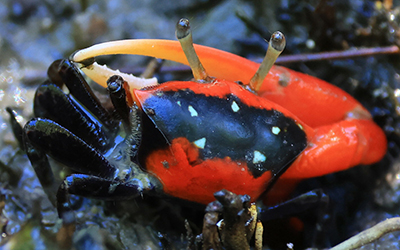
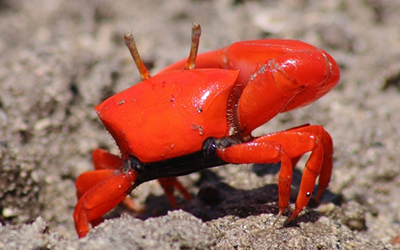
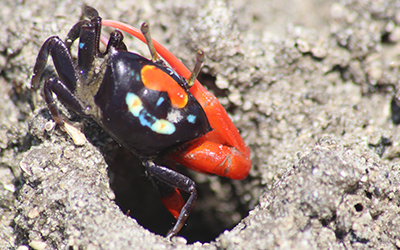
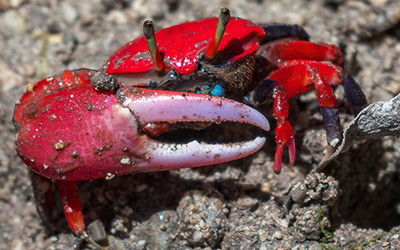
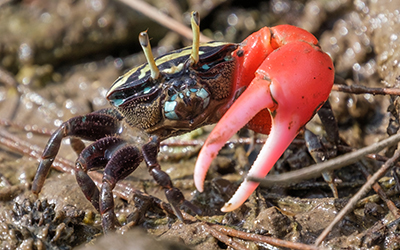

Gelasimus excisa is an endemic that is readily identifiable by both color and shape. Its large claw is strikingly two-toned, generally yellow on the bottom half and white or pink on the upper half; sometimes there is a darker orange spot aroudn the base of the lower finger. Its carapace is usually a pale yellow-white, but may be other darker colors, including black and green. Its legs are frequently yellow.
Although Gelasimus excisa has some superficial color similarity to Austruca citrus the species are easy to tell apart. Beyond the narrow vs. broad front distinction, the entire claw of Austruca citrus is yellow, while only the lower half is yellow in Gelasimus excisa. The shape of the large claw is completely different, with Austruca citrus having a fairly straight fingers while Gelasimus excisa will usually have the more obviously toothed form of the subgenus Gelasimus (regenerated claws may lack the toothiness).
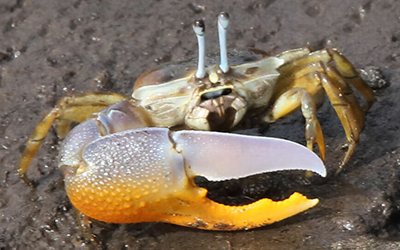
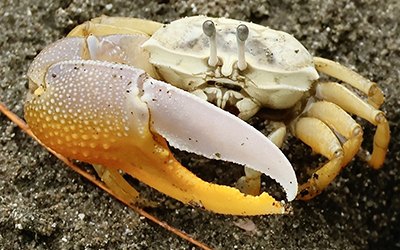

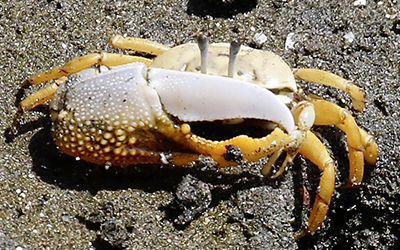
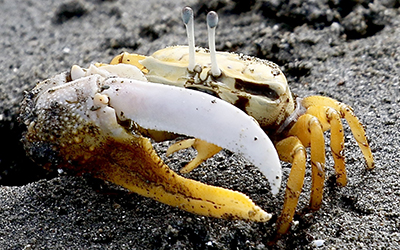
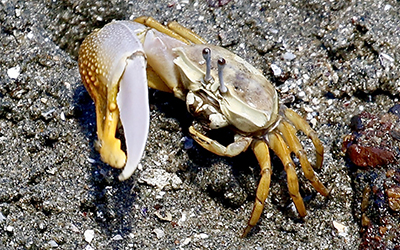
Gelasimus tetragonon is a wide-spread species that is something of an oceanic island specialist, although it is occasionally found on continental shores. It usually has a predominantly blue and black carapace with bright red legs (which occasionally may be darker) and gray eyestalks. The large claw of Gelasimus tetragonon is usually orange, with a noticeably darker red spot near the base of the pollex, and a white dactyl. Gelasimus tetragonon frequently has brown spots on the top part of the hand of the claw.
Gelasimus tetragonon has a lot of additional variability. In some places the carapace can lighten so that there is almost no blue, just a cream or pale orange with black markings. The pattern of the colors on the carapace can vary from stripes or blotches to tiny spots.
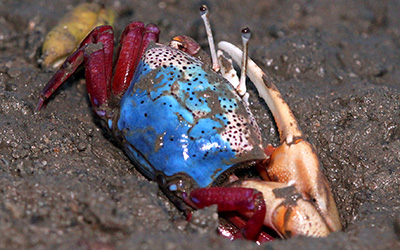
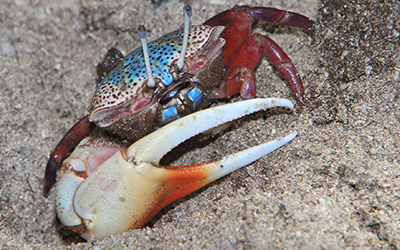
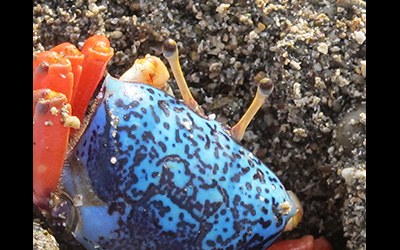
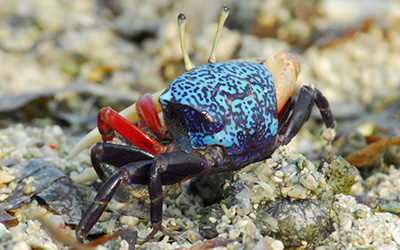
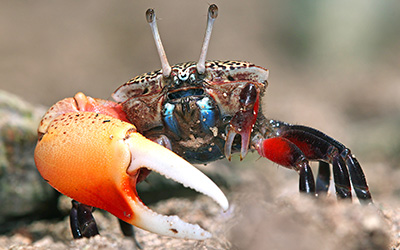
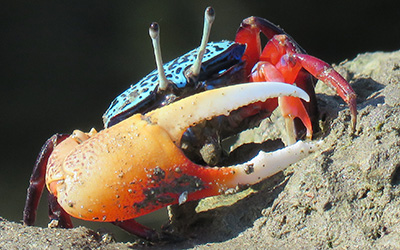
Tubuca coarctata is a highly variable narrow front species that is most likely to be confused in this region with the broad front species Paraleptuca crassipes. On average, front breadth might be the easiest way to distinguish these as the high variaiblity of both species creates a lot of general overlap in color pattern.
The most common carapace pattern in Tubuca coarctata is a mostly black carapace with some spots of pale blue, yellow, red, or white. In many cases, however, individuals may have carapaces that appear nearly solid of any of these colors or consist more of two-toned stripes of two of these colors (the latter pattern might be more common in females than males).
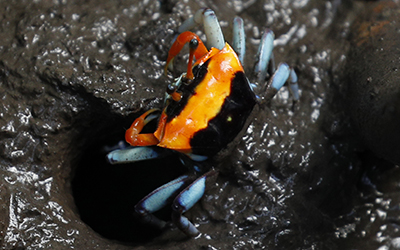

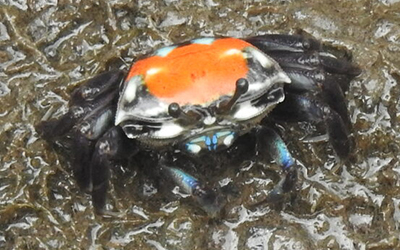
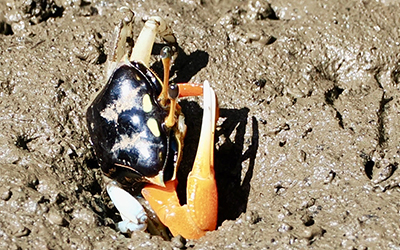
The legs of Tubuca coarctata generally follow this same color variation as the carapace, although the two rear legs generally have a large distinct, pale blue (sometimes almost white) blotch on the rear of the the top segment. This color will sometimes spread beyond this segment.
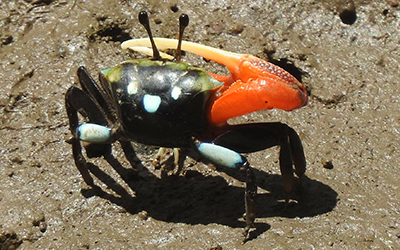
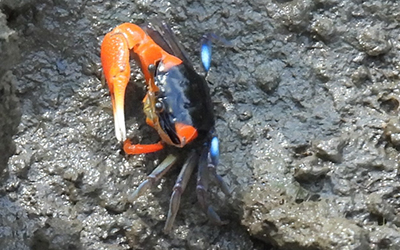

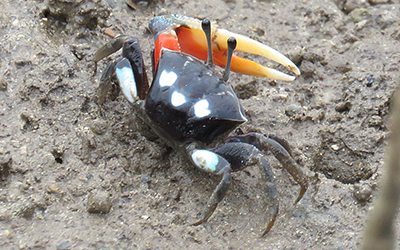
The large claw usually has a red or orange hand, with most of the upper finger and the outer half of the lower finger white. Sometimes the white will bleed further onto the upper part of the hand. There is also usually a darker red patch at the base of the lower finger (as is common in many other species). The prototypical male Tubuca coarctata has a distinct an obvious flat edged projection along the lower portion of the tip of the upper finger of the large claw. In some individuals this feature is more subtle, while other species may have a claw shape that is at least somewhat similar, although within this region this shape is more-or-less unique to this species.
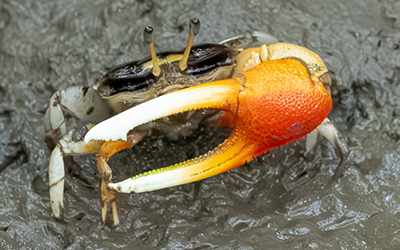

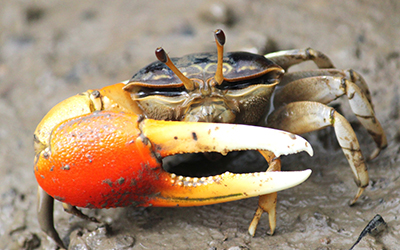

Other than front breadth, the most likely methods of distinguishing Tubuca coarctata from Paraleptuca crassipes are the shape of the tip of the large claw and the presence of the blue spots on the backs of the rear legs. Paraleptuca crassipes also leans much more heavily toward bright reds than Tubuca coarctata, whose redder forms are more orange.